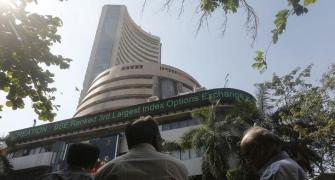A college student in Pune discovers that the graveyard near his house is being dug up. He gets hold of a video camera, pans the scene and hands it over to CNN-IBN. Actor Prithviraj's autistic son is not allowed to board an aircraft.
With a camera handy, the actor is able to capture the callousness of security guards. A little boy falls into a deep hole in the ground and for over 24 hours viewers are transfixed as they watch the child being rescued.
Conventional thinking has it that Indians are not a news-hungry nation, but news stories like these, many of them sent in by viewers, appear to be working. It's not a trend that has gone unnoticed.
Says Lakshmi Narasimhan, national director, Group M Media: "Part of the audience is definitely moving away from mass channels to news channels."
It's showing in the numbers too. A couple of years ago, the audience share commanded by the news genre was a pitiful 3 per cent, in 2004 it moved up to 5.4 per cent and at the end of 2005 it was 6.5 per cent. But of the nearly 100 million television households in the country, barely 1-1.5 per cent view English (including business) channels.
Marketers are certainly waking up to the potential. Farokh Balsara, partner, media and entertainment, Ernst &Young, says that of the total advertising revenues for television of Rs 5,500 crore, news channels are estimated to have a share of Rs 700-750 crore, up from Rs 645 crore at the end of 2005.
The lion's share belongs to Hindi channels, with English channels accounting for 25-30 per cent or somewhere in the region of Rs 200-225 crore. What's key is that at 30 per cent a year, advertising revenues for the genre have grown the fastest.
And the emergence of strong contenders such as CNN-IBN is making marketers sit up and take notice.
Launched in mid-December 2005, the channel, according to TAM Peoplemeter, has notched up an audience share of 31 per cent (January-September 2006) -- against Times Now's 15 per cent and NDTV 24x7's 38 per cent.
Says Rajdeep Sardesai: "I don't believe there can be monopolies in television, so there was space for us to come in."
But is it that easy to break into the market and gain marketshare? Entry costs are not quite prohibitive: a start-up channel like Times Now, a joint venture between Reuters and Bennett Coleman & Co, is believed to have spent Rs 60-80 crore, and a venture from an existing broadcasting house could be still cheaper.
Moreover, as G Krishnan, executive director and CEO, TV Today Network, points out, "Coming from a reputed media house makes a big difference. Sound business planning and experienced industry hands help greatly."
But Sunil Lulla, CEO, Times Now, doesn't agree with the low-cost entry proposition, arguing that distribution or carriage costs can pinch. "With subscription revenues practically non-existent, we need to pay the multi-service operators huge sums just to stay connected."
Times Now is estimated to have spent Rs 18 crore on carriage fees, much less than CNN-IBN's estimated Rs 25 crore.
Nor is news gathering cheap, given the expense of technology and people. "On a conservative estimate, we need Rs 50 crore annually to run the business," claims Lulla. Typically, he says, this is likely to be "as much as Rs 70-80 crore".
Then how has CNN-IBN pulled off what others have failed to? Lulla believes his rival's success stems from its ability to get the distribution strategy right: "They invested in distribution and managed to get shelf space." TV Today's Krishnan too feels that placement is important, though "good content will hold the viewer's attention longer".
That's where CNN-IBN appears to have scored too. Industry watchers feel the "participative nature" of CNN-IBN's interactive shows Public ka Kaptan and Citizen Journalist have been a big plus.
A senior executive from India's biggest broadcasting house observes that "the channel does not talk down to the viewer, it talks to him." Adds Raj Gupta, chief strategy officer at Lintas Media Group: "The reason CNN-IBN has become popular is because it comes across as a youthful channel and has a tempo that is faster than that of NDTV 24x7."
Ernst & Young's Balsara agrees that beyond getting the distribution right, "CNN-IBN came with a pedigree brand in CNN and a strong editorial team with Rajdeep Sardesai. The channel has an editorial style that appeals to a section of people."
Adds Punitha Arumugam, group CEO, Madison Communications, "You can't say the entry barriers are low; the quality of content has to be sustained."
According to Arumugam, the fledgling channel has done a good job of promoting itself, and much of the competition believes Rajdeep Sardesai is a strong brand himself, while programmes like Citizen Journalist have played a role in building loyalty.
"It's not always the numbers that matter, it's the emotional involvement," points out Lulla. Observes Sardesai himself, "We believe aggression is missing in Indian journalism today and we want to bring that in. That's not easy."
Besides the credibility of the CNN tag, the marketing team took branding initiatives with leading newspapers such as The Hindu, Indian Express and Deccan Herald, to break stories together.
Says Dilip Venkatraman, director marketing, Global Broadcast News: "We got tremendous mileage by teaming up with the papers and reaching out to audiences that partly overlapped with the channels."
Media buyers who admit they didn't believe CNN-IBN could establish itself so soon, are now coming round. Says Group M's Narasimhan: "We are using CNN-IBN for our clients because it is becoming a significant challenger."
Lintas' Gupta, who advised Idea Cellular to sponsor Citizen Journalist because 'it was a brand-building property, different and would give Idea visibility,' confirms recommending the CNN-IBN platform. Of course, NDTV 24x7 still commands a big premium for its slots. "I think we'll command this for a long time," says Raj Nayak, chief executive, NDTV Media.
However, Nayak concedes that slots on NDTV Profit -- the English business channel -- are going at a 40 per cent discount to rival channel CNBC TV18's slots.
According to TAM Peoplemeter System, CNBC TV18 commanded a 67 per cent relative market share compared with 33 per cent for NDTV Profit (CS AB 15 years plus, six metros) between January-September. CNBC TV 18's success is attributed by industry watchers to the quality of its content.
Says a media buyer: "NDTV Profit didn't do anything different from the incumbent, so viewers had little reason to switch. The news space tends to become commoditised. However, a couple of channels stand out."
Says Narasimhan: "CNBC TV18 has become almost like a home page for decision-makers and does not have an identity crisis."
Retorts Nayak: "We do not believe in TAM. According to us, we are neck and neck with CNBC TV18." However, Dhanraj Bhagat, practice leader, Grant Thornton, says, "Apart from content, the quality of anchors too makes a big difference."
NDTV Profit, however, attracts all the top brands and commands revenues of over Rs 40 crore, according to Nayak. With more advertising money moving to news, the channel has benefitted.
Says Nayak: "With so much fragmentation in genres across television, advertisers find news emerging as an effective way to target audiences. Marketers realise spending on live cricket may be more costly and less meaningful than advertising on a news channel -- because the same budget can fetch you many more slots over a longer period of time."
Bhagat believes the margins for channels too can be very attractive after the initial gestation.
"Though operating costs may be high, the leverage will kick in once viewership grows and a channel is able to command premium rates," he explains.
And there are enough reasons why the genre will grow: a low base, a growing educated and working population, demographics skewed in favour of the young, a booming economy and stock markets, and enough catastrophes and calamities to keep viewers hooked.
Moreover, as Balsara, points out, "Most news channels are throwing in entertainment, cricket-based shows and general trend stories for good measure."
Marketers are aware of the huge purchasing power of the younger audience. "It's a new trend. English channels are attracting youngsters between the ages of 29-34 and are therefore beginning to get ad revenues," says Balsara, who estimates ad revenues for the genre could grow at 18 per cent in the next few years.
That's possibly why the space is going to see more entrants. There is talk of an English news channel from Reliance Industries and an English business channel from the TV Today Network. But not everyone will make money.
Says Krishnan, "There is definitely potential, but for a new channel to gain a foothold will be an uphill task."
Add to that falling tariffs -- media buyers say NDTV 24x7's pricing is bound to be impacted sooner rather than later -- and it certainly doesn't look like it's going to be easy for anyone.
What will ease the pressure, to some extent, is increasing digitisation (CAS and DTH) which, as Lulla points out, would take away the pain of distribution. Then, the future may lie in differentiated, niche channels, as in the West.
The consumer, of course, will continue to call the shots.








